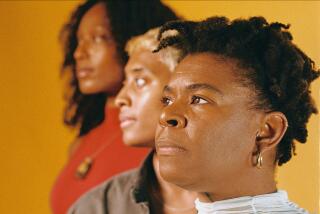The Free Cafe wants to talk about gentrification. But some say it’s part of the problem

- Share via
Michael Rippens is learning firsthand the cost of good intentions.
Nearly three years after moving to Leimert Park in 2014, the cultural heart of black Los Angeles, he decided to bring people together to talk about weighty issues such as neighborhood identity and gentrification. He began transforming his backyard into a monthly pop-up he calls the Free Cafe. The event draws crowds several dozen strong for coffee and conversation.
It’s a hip, photogenic affair. A menu lists the price of coffee, tea and lemonade as “Free” and includes the event’s Instagram handle. There’s a display board where people can pin up handwritten notes or sketches that, likely, will be displayed on social media. For a while, he ran other pop-up cafes, including one in Leimert Park Plaza.
But to some longtime residents, Rippens, 41, has become a face of gentrification: An artist of white and Filipino heritage who moved to Leimert Park with his partner, Irene Silva, a 42-year-old graphic artist who is Portuguese and Micronesian.
Early rumblings appeared on the hyper-local social networking website Nextdoor, where Rippens was criticized for serving free coffee near black-owned coffee shops such as Hot & Cool Cafe and Harun Coffee during one of his pop-up events.
“People were thinking, ‘This is just a benign free cafe,’” said Lawrence Ross, 53, a longtime Leimert Park resident. “But I was the first one to bring up, ‘Wait a second — you think this is benign, but what about the [black-owned] cafe that is about 500 feet away from you? You think this is a small thing, but every time you give away a free something to someone, they’re not purchasing something from this business that depends on receipts.”
After a moment of doubt about whether to proceed with the Free Cafe, Rippens responded by doubling down on his good intentions.
He invited Ross to the pop-up. (Ross didn’t go, and doesn’t plan to go to the Free Cafe’s backyard gathering either). He also reached out to the owners of the other coffee shops to explain the Free Cafe’s purpose. He and one of his supporters purchased coffee beans and pastries from Hot & Cool Cafe to give away for free at the event, in an attempt to mitigate any negative effect it might have on its business.
“I wanted to create a work that could serve and benefit my neighborhood, but I certainly didn’t want to become a contributing factor to the negativity and divisiveness that I viewed online,” Rippens said. “I began to see how the Free Cafe project, just like a Starbucks on Jefferson [Boulevard] or an art gallery in Boyle Heights, might be viewed as a threat to someone’s community or way of life.”
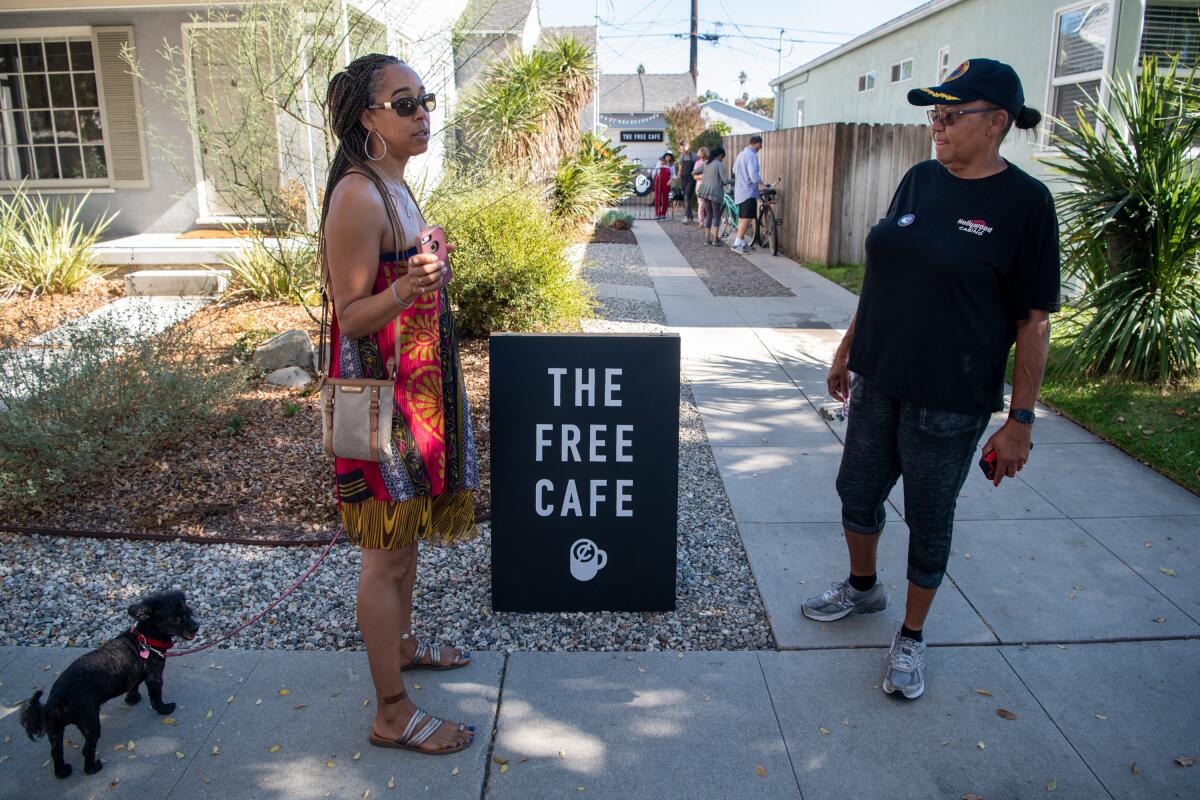
In many of L.A.’s working-class neighborhoods, which used to be predominantly African American, Latinos now make up the majority. And for more than two decades, the city’s black population has been declining.
A Times analysis of census data shows that the black population in L.A. has declined from 500,000 in 1970 to 333,000 last year. Fifty years ago, blacks represented 18% of the city; as of 2018, they made up about 8% of L.A.
Leimert Park’s symbolic importance is indisputable. The neighborhood, which is nestled at the foot of Baldwin Hills, remains one of the few places where blacks are a strong majority. But long before it became a home for many of the city’s African American elites, it was far from welcoming. Leimert Park started out as a solidly white enclave, protected by white-only real estate covenants. The neighborhood began to shift only when the U.S. Supreme Court invalidated the racist restrictions in 1948.
After the 1965 Watts riots, even more whites fled neighborhoods such as Leimert Park. The 1992 L.A. riots economically battered neighborhoods in South L.A., which saw a sharp increase in gang violence but an increasing scarcity of quality grocery stores and supermarkets, sit-down restaurants and investment. But in recent years developments have crept back into these neighborhoods.
With an influx of projects including rail lines, new businesses, high-rises and an NFL stadium in nearby Inglewood has come an increasing number of non-black residents into places such as Leimert Park. That has caused worries about black people being priced out of many of these neighborhoods at a time of growing optimism about economic opportunity there.
Intense fights over gentrification have happened across L.A. from Venice to Boyle Heights, where activists protested against the opening of art galleries and a cafe.
In Leimert Park, the issue surfaced after a selfie of a Leimert Park running group in 2016 showed a majority of white members. The Free Cafe pop-up last year, inevitably, caused some unease.
At the time, the Free Cafe was hosting a series in conjunction with the art program Maiden LA that was traveling to other gentrifying neighborhoods including Boyle Heights, Historic Filipinotown and Highland Park. The goal, Rippens said, was to spur dialogue.
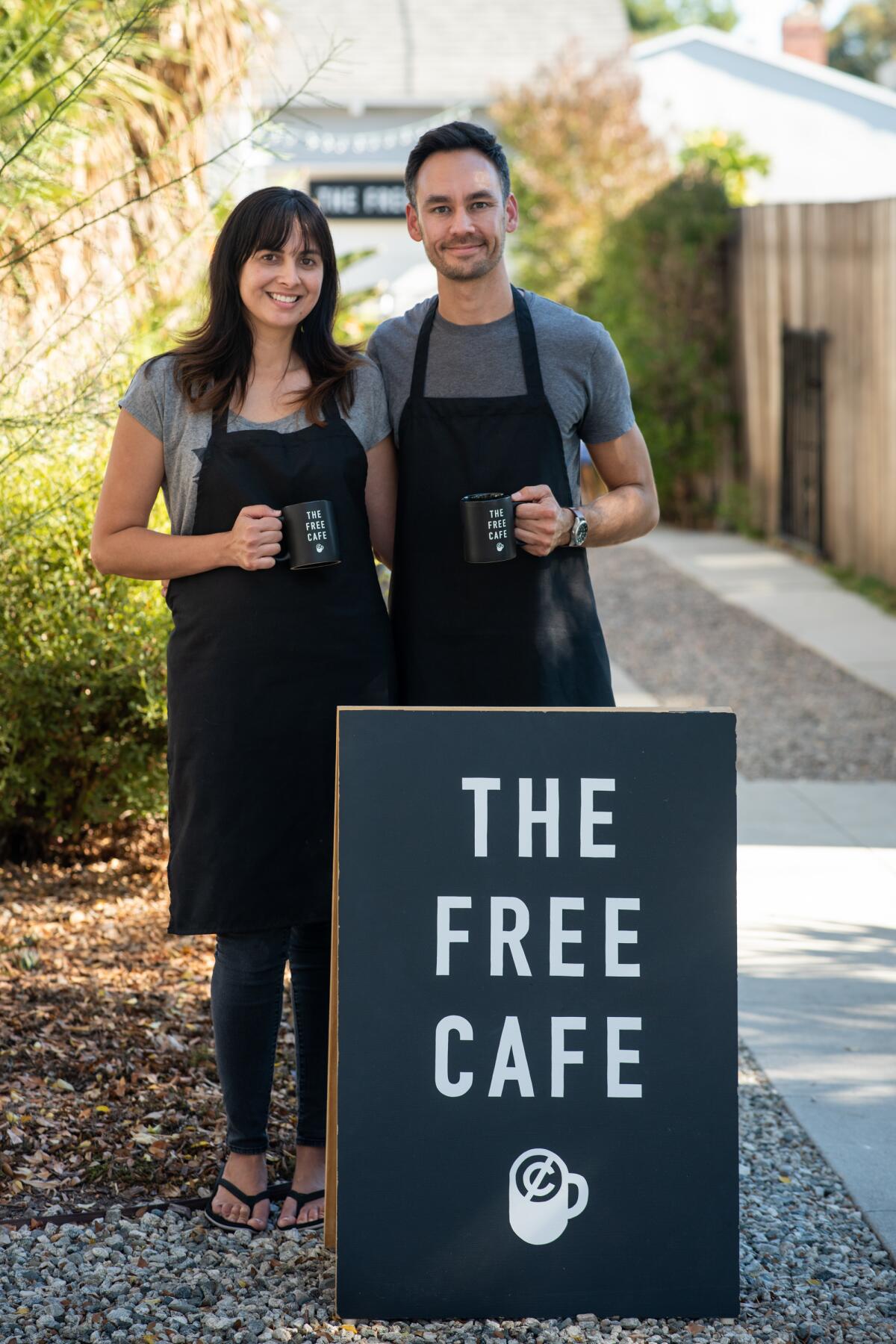
When he announced on Nextdoor that the Free Cafe would end the series in Leimert Park Plaza — the cultural nucleus of the neighborhood — it drew the attention of Ross, a 20-year Leimert Park resident who is a partner at the Metaphor Club, a black-centric creative and co-working space on Crenshaw Boulevard. Ross, who writes and lectures about racism at college campuses, saw the pop-up as a microcosm of the tensions within the community.
“People who move into communities like Leimert Park typically think of themselves as good people — and God help them — they probably are good people,” said Ross, who is black. “But they’ve never, ever had to think about the dynamics of the community which they’re moving into.”
There is a difference, Ross said, between being in the community versus being of the community. The way Ross sees it, to be in the community is to expect it to form and change around you; to be of the community is to make a sincere effort to integrate into it.
The cafe attracted people from disparate backgrounds who sometimes found common ground. In October, Sanae Washington, a probation officer and lifelong Leimert Park resident showed up for the first time, at the urging of Rippens and Silva, who are her neighbors. Washington, who is black, understood the insecurity that many black residents feel in fast-changing neighborhoods they could be priced out of. But she came to see the value in the forum provided by the Free Cafe.
“I think it’s important to pull people together,” she said, “because if we don’t, then nobody understands what the other person is thinking and it’s all misinterpreted.”
Madeleine Ildefonso, 48, is a white librarian who moved to Leimert Park in 2016 with her Latino artist husband. After arriving in L.A. in the 1990s, she finally achieved her dream of owning a home in Leimert Park. Ildefonso said she could imagine the anxiety that some black neighbors might feel over gentrification. While house hunting in Leimert Park three years ago, she remembers watching sharply dressed elderly black women leaving church on a Sunday and thinking how quickly their generation could be gone from the neighborhood.
Ildefonso said despite her efforts to participate in Leimert Park’s network of groups and events, she remained nervous about how someone like her would be perceived. The Free Cafe provided another outlet to wrestle with those feelings, she said.
“Being able to have conversations about perspectives and different lenses where it’s not just a perspective you read about, it’s a perspective you’re hearing from someone who has lived here for a long time” is important Ildefonso said. “You may not always agree, but it’s a person disagreeing.”
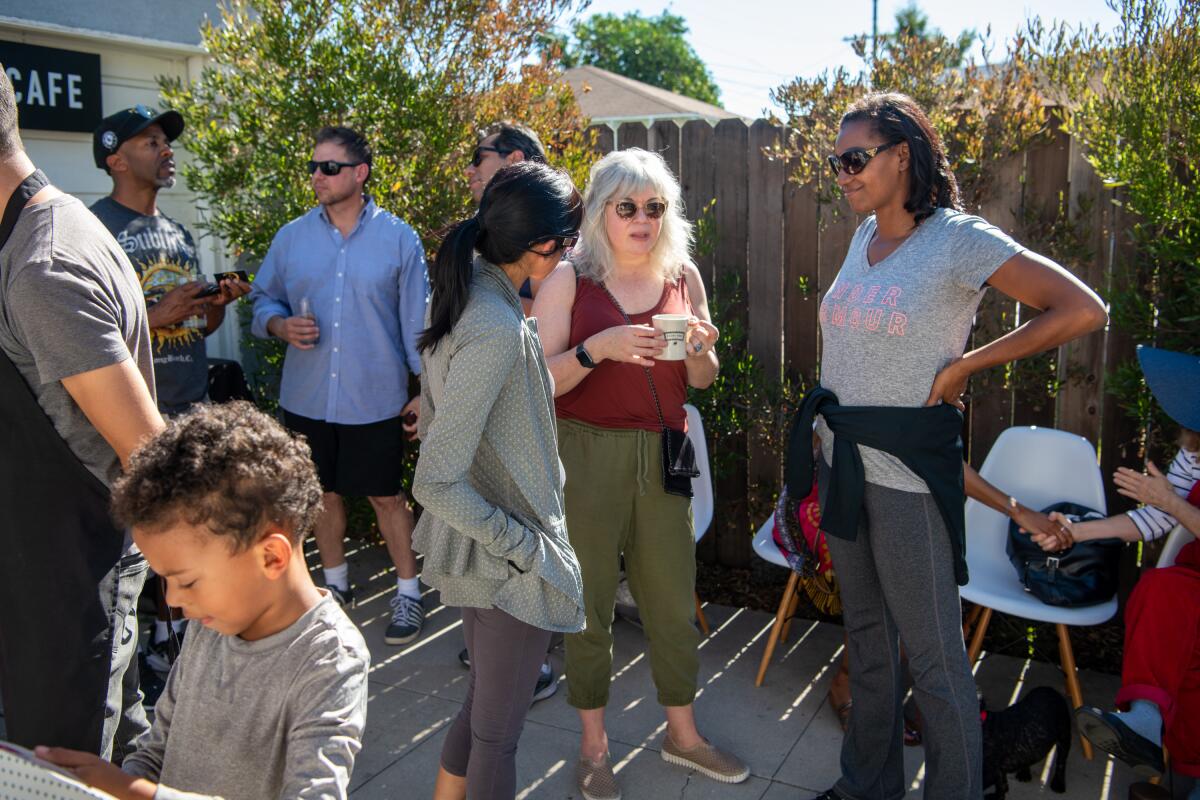
Rippens promotes the Free Cafe on Nextdoor to the Leimert Park neighborhood as well as surrounding areas such as Jefferson Park and West Adams.
He credits the site as a valuable tool for getting the word out about the Free Cafe, but because there is no face-to-face interaction, discussions on serious neighborhood issues can become even more polarizing on such an online forum. In that regard, he and Ross agree.
“What happens on Nextdoor in particular is that you have [two] groups of people: The ones who are like, ‘This neighborhood is absolutely changing. I really hate this. This is a black neighborhood,’” Ross said. “Then you have the people who are like, ‘This is just a neighborhood. I don’t see gentrification. Can’t-we-all-just-get-along-kumbaya-ish.’”
But the reality is more complicated than both views, Ross said.
Dorothy Rodgers, 71, who is black, has lived in Leimert Park since 1982. She said she is “loving the changes” in her neighborhood.
She agrees that it shouldn’t have taken a new wave of white people moving in to get things she’s been wanting in her community for years — more organizations and events, a grocery store with healthy, organic food, and renovations to her local bank. But she’s just happy it’s finally happening, Rodgers said.
She said she prefers the Free Cafe setting over Nextdoor because it offers a more moderate perspective.
Silva, the Free Cafe’s co-host, said she thinks the monthly event serves a need.
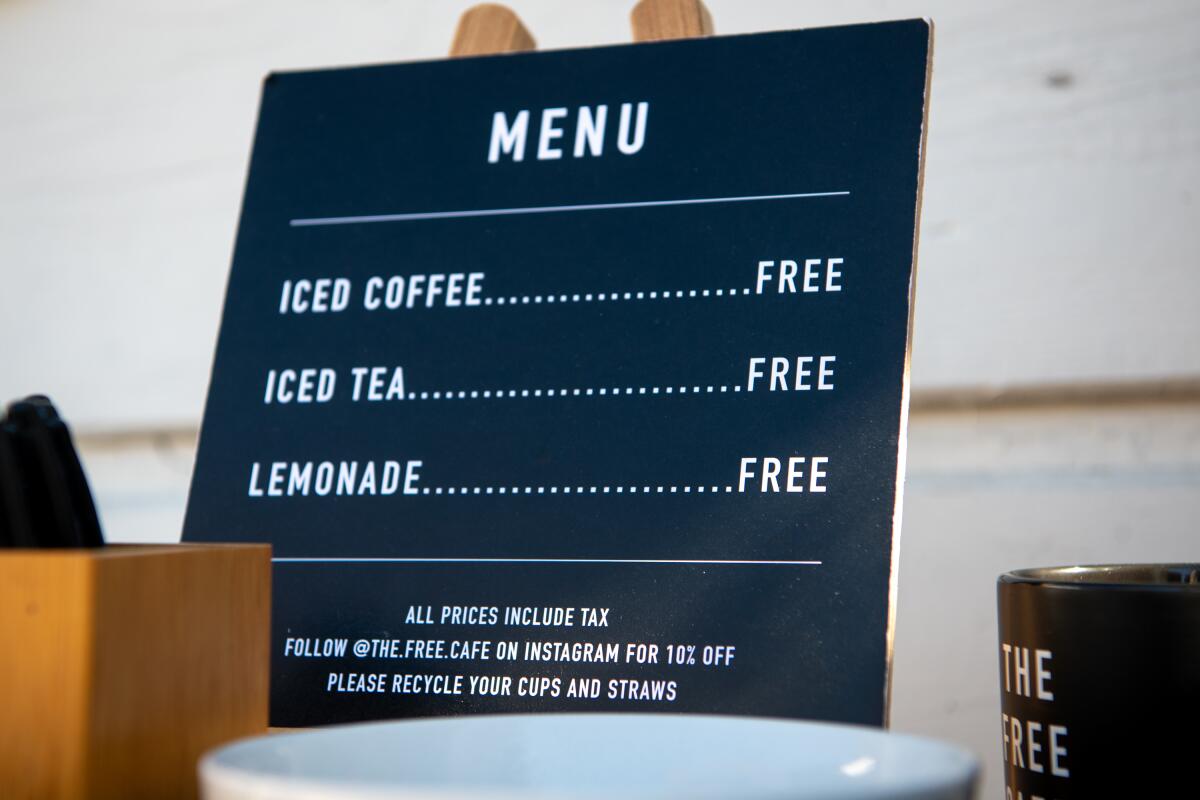
“There’s the desire for this,” she said. “And it could exist anywhere.”
In October, Rippens and Silva set up in the frontyard of the home of Mike Nobrega, a member of the Arlington Heights Neighborhood Assn. They estimated that more than 40 people showed up over a three-hour span.
“I understand that doing socially engaged art projects in Leimert Park will always be tinged with racial and cultural issues,” Rippens said. “And that to some I’ll forever be seen as a newcomer or an outsider who doesn’t quite belong in this neighborhood.”
He said the Free Cafe was an “authentic and sincere” attempt to create conversation.
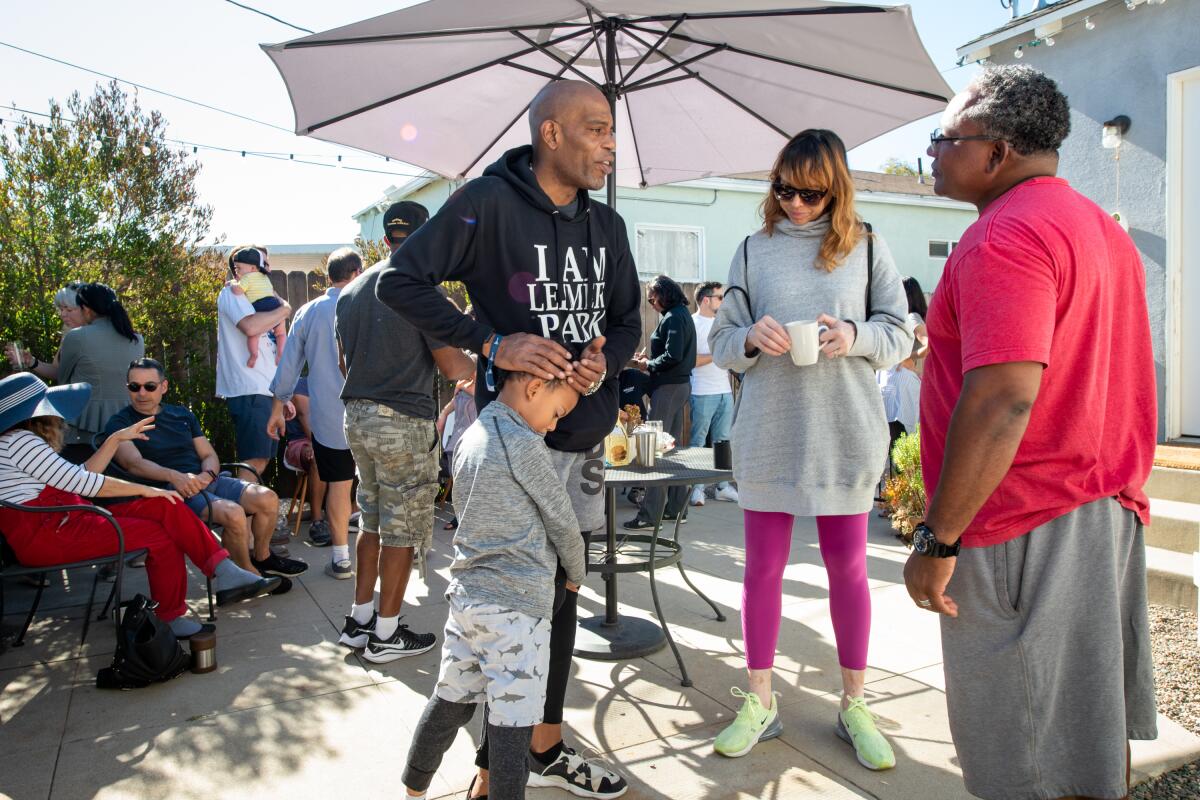
Anthony Jolly, the 45-year-old co-owner of Hot & Cool Cafe, said he is all for a casual coffee shop setting that builds community. His establishment aimed to be that for Leimert Park when it opened in 2018. But unlike the Free Cafe, the countless patrons who poured into Hot & Cool Cafe on a November weekday were, like the neighborhood, mostly black.
The cafe’s apricot-colored walls are adorned with large Afro-centric paintings such as Nneka Osueke’s “Ekure’s Prayer, Ekure’s Return.” Its shelves house countless albums and books by black artists. And former President Obama’s bobble head sits still on the counter next to the Jamaican black seed oil for sale.
Jolly remembers the pop-up controversy, and he still thinks about it a year later. He wondered why the people who showed up for the Free Cafe event in 2018 don’t regularly show up at Hot & Cool Cafe or Harun Coffee, across the street on Degnan Boulevard. Jolly’s theory was that his business’ “unapologetic blackness” may be intimidating to newer residents who are not black.
Jolly’s coffee shop has also become a haven for many of the neighborhood’s homeless people, who eat there and use its restroom. To truly be part of a neighborhood, like Leimert Park, can be an uncomfortable affair. And maybe it should be, Jolly said.
“If the Free Cafe is open, will they let [homeless people] come in and charge their phones?” Jolly asked. “Will they let them come in and use the bathroom?”
Times staff writer Sandhya Kambhampati contributed to this report.
More to Read
Sign up for Essential California
The most important California stories and recommendations in your inbox every morning.
You may occasionally receive promotional content from the Los Angeles Times.


